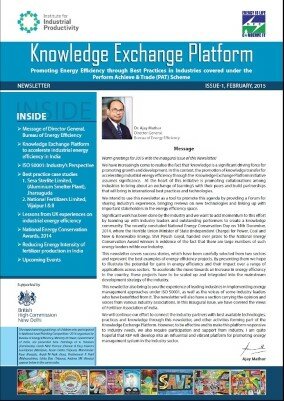ACTION EXCHANGE, ENERGY EFFICIENCY SUPPLY CHAIN PROGRAM

Action Exchange helps companies and their supply chains identify the energy efficiency measures that yield the best return on investment.
Action Exchange was created to address the barriers faced by multinational corporations in encouraging their supply chain companies to become more energy efficient.
IIP teamed up with CDP on the development and implementation of the initiative, and drew on CDP’s already successful Supply Chain program to identify the obstacles companies faced and create the solutions that could bring them better energy performance over the long term.
The pilot phase of Action Exchange ran from September 2013 to August 2014 and involved five leading CDP Members – the Bank of America, L’Oréal, PepsiCo, Philips, and Walmart. A total of 65 core suppliers participated in the pilot phase, and in aggregate are estimated to have emission reduction opportunities of 5 MTCO2-e. In Phase 2, at least 188 will be joining, with estimated emissions reduction opportunities of 9.9 MTCO2-e.
How Action Exchange works
Action Exchange helps embed energy efficiency into companies’ decision-making processes. Partnerships created through the initiative are intended to grow, bringing continuous energy efficiency savings beyond the lifetime of their involvement.
Action Exchange uses multiple resources to assist participating suppliers improve their carbon and energy performance. At the core of the program is a database of corporate environmental information, which is based on annual disclosures from companies to CDP’s supply chain questionnaire. Other resources include a bank of technologies, measures and case studies on best practice energy efficiency projects. These tools are used to evaluate a supplier’s basic level of energy efficiency and recommend a clear pathway for improvement and cost savings. Each supplier is analyzed individually and receives an emissions reduction profile, tailored for their specific sector and location.
As a follow-up, personalized introductions are made between a supplier and a solutions provider to help them access cost-efficient emissions reduction technologies and services.
As part of Phase 1 of the program, detailed energy assessments were also offered free-of-charge to selected suppliers to help them identify profitable energy efficiency and emissions reduction projects. Two detailed energy assessments were undertaken with Philips electronics component suppliers to identify profitable energy efficiency and emissions reduction projects that will lead to energy cost savings, productivity improvements and other benefits. These examples are being shared with suppliers of CDP supply chain program member companies that may be just starting their own energy efficiency activities and are interested in learning about both the energy-saving and non-energy benefits associated with implementation of energy management systems and energy efficiency projects.
See the case study on two of Philips’ supplier companies in China.
Future phases of the program
In Phase 2, the Action Exchange model is being deployed on a greater scale and is seeking partnerships with international development banks to offer energy efficiency financing for participating suppliers. Members cover a wide range of markets and industries and include Braskem, BT Group, Cisco, Dell, Diageo, General Motors, Jaguar Land Rover, JT International, L’Oréal, Metlife, Nokia Solutions and Networks, Philips, Unilever and Walmart.
To find out more about this phase of the program, please contact us:



